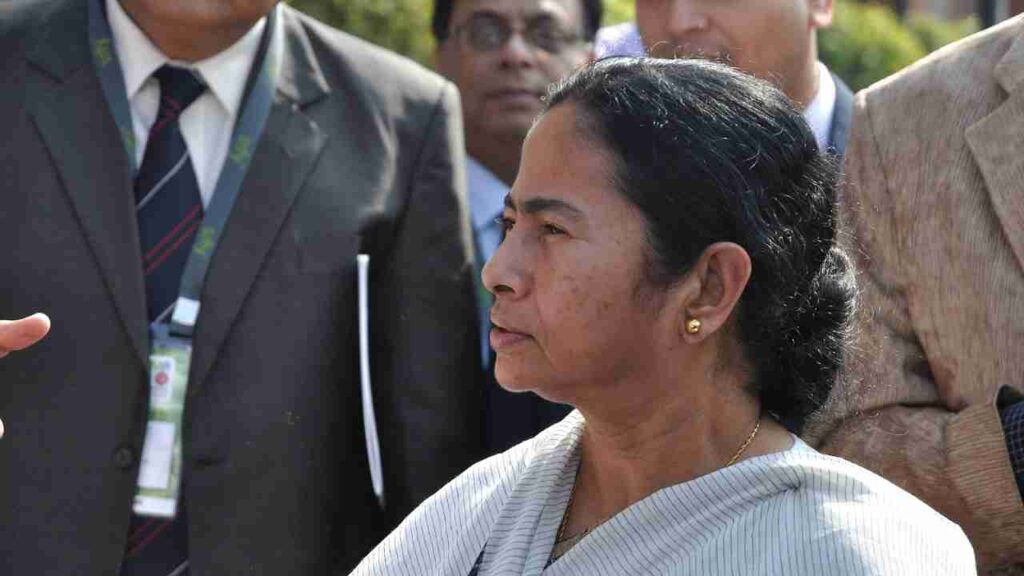‘BJP Washing Machine’ : In a dramatic display of dissent, West Bengal Chief Minister and Trinamool Congress (TMC) supremo Mamata Banerjee initiated a two-day sit-in demonstration in Kolkata. The protest aimed at condemning what she perceives as the Centre’s discriminatory attitude towards the state. Alongside TMC leaders, Banerjee utilized the platform to launch scathing criticisms against the BJP government, utilizing a symbolic giant washing machine labeled as the ‘BJP Washing Machine.’
‘BJP Washing Machine’ Mamata Banerjee’s Taunt Amidst Rare Protest Against Modi Government

Key Points:
Call for Opposition Unity:
Mamata Banerjee urged all political parties in India to unite against the BJP government in the upcoming 2024 elections. She emphasized that the focus should be on a united front to counter the BJP, stating that it’s not about leadership but a collective fight of the people against the ruling party.
Symbolic ‘BJP Washing Machine’:
Mamata Banerjee’s utilization of the ‘BJP Washing Machine’ during her protest carries a multi-layered and symbolic message, revealing a significant aspect of her critique against the BJP government. This unique approach serves as a metaphorical commentary on the treatment of opposition leaders under BJP rule.
1. Allegation of Harassment: The ‘BJP Washing Machine’ is a visual representation of Mamata Banerjee’s strong allegation that under the governance of the Bharatiya Janata Party (BJP), opposition leaders face harassment by central agencies. By choosing the metaphor of a washing machine, she implies a forceful and intrusive process that transforms individuals who oppose the BJP.
2. Transformation of Image: Mamata Banerjee goes beyond a straightforward accusation by metaphorically suggesting that the BJP possesses a transformative mechanism. She contends that individuals who were once part of the opposition and critical of the BJP undergo a drastic change in perception and image after joining the party. The washing machine becomes a metaphor for this transformative process.
3. Likening to Innocence of a Lamb: The Chief Minister adds a touch of sarcasm by likening the transformation process to the innocence of a lamb. This imagery conveys a sense of naivety or purity, suggesting that the BJP’s process of transformation not only alters the political stance of individuals but also portrays them as innocent and blameless, erasing any previous critiques or controversies.
4. Satirical Mockery: The use of the ‘BJP Washing Machine’ is a form of satirical mockery employed by Mamata Banerjee to question the sincerity and authenticity of the BJP’s political narrative. The visual representation serves as a tool to ridicule the BJP’s ability to cleanse and purify the political standing of those who align themselves with the party.
5. Visual Impact: The choice of a giant washing machine as a visual prop adds a theatrical and impactful element to Mamata Banerjee’s protest. The size and visibility of the prop make it a focal point, ensuring that her message is conveyed not only through words but also through a striking visual metaphor.
6. Reinforcement of Critique: By placing the ‘BJP Washing Machine’ at the center of her protest, Mamata Banerjee reinforces her broader critique of the BJP government. It becomes a tangible representation of her concerns about the alleged misuse of power and the impact on the political landscape, emphasizing the need for opposition unity against what she perceives as an oppressive regime.
In essence, the ‘BJP Washing Machine’ serves as a powerful and nuanced symbol within Mamata Banerjee’s protest, encapsulating her allegations of harassment, critiquing the transformative nature of joining the BJP, and using satire to question the authenticity of the party’s image-building process.
ALSO READ : Vijay’s Cinematic Farewell : A Pioneering Journey from Films to Politics
Responsibilities as CM and TMC Chairperson:
Banerjee clarified her dual role as the Chief Minister of West Bengal and the TMC chairperson. She stated that when she witnesses the suffering of the people of her state, it is her responsibility to address it. Despite being the head of the state government, she asserted that the demonstration is conducted on behalf of her party, not the state government.
Opposition’s Fight Against BJP:
Highlighting the need for opposition unity, Mamata Banerjee stressed that the battle is not about who becomes the leader but about the people of the country collectively standing against the BJP. She called for the opposition to unite and successfully challenge the BJP to save the country.
Financial Allegations Against Centre:
The sit-in protest was initiated in response to the alleged “stoppage” of funds to the state for schemes like MGNREGA and others related to housing and road departments. Banerjee accused the Centre of obstructing financial aid crucial for the state’s development.
Double Duty and Non-Utilization of Government Funds:
In a subtle dig at the BJP, Banerjee claimed she is performing double duty as both the Chief Minister and TMC chairperson. Unlike the BJP, she asserted that she is not using government funds for the demonstration. The Chief Minister highlighted the transparent use of party resources and dedication to the cause.
Call for Democracy and Secularism:
Mamata Banerjee concluded by emphasizing the importance of democracy and secularism, symbolically placing a copy of the Constitution at the protest site. She declared her commitment to preserving the democratic values of the nation and called for a collective effort to “save India, save democracy.”
As the two-day sit-in continues, Mamata Banerjee’s protest against the Centre’s alleged discriminatory actions remains a focal point, drawing attention to the larger narrative of opposition unity and the impending 2024 elections.
- Why did Mamata Banerjee initiate a two-day sit-in demonstration in Kolkata?Mamata Banerjee initiated the protest to condemn what she perceives as the Centre’s discriminatory attitude towards West Bengal.
- What symbolic gesture did Mamata Banerjee use during the protest?Mamata Banerjee used a giant washing machine labeled ‘BJP Washing Machine’ as a symbolic taunt against the Modi government.
- What does the ‘BJP Washing Machine’ symbolize in Mamata Banerjee’s protest?The washing machine symbolizes Mamata Banerjee’s allegation that under BJP’s rule, opposition leaders face harassment by central agencies, and joining BJP transforms their image.
- What message did Mamata Banerjee convey through the ‘BJP Washing Machine’?The washing machine signifies the Chief Minister’s criticism of the BJP’s ability to change the image of opposition leaders who join the party, likening it to the innocence of a lamb.
- Why did Mamata Banerjee call for opposition unity during the protest?Mamata Banerjee called for opposition unity, emphasizing that the fight is not about leadership but a collective effort of the people against the BJP in the 2024 elections.
- What financial allegations did Mamata Banerjee make against the Centre during the protest?The protest was initiated in response to the alleged “stoppage” of funds to the state for schemes like MGNREGA and others related to housing and road departments.
- How did Mamata Banerjee clarify her dual role as Chief Minister and TMC chairperson?Banerjee clarified that when she witnesses the suffering of the people of West Bengal, it is her responsibility as both the Chief Minister and TMC chairperson to address it.
- Why did Mamata Banerjee state that the demonstration is on behalf of her party, not the state government?Despite being the head of the state government, Banerjee asserted that the demonstration is conducted on behalf of her party, not the state government.
- What did Mamata Banerjee say about her use of government funds during the protest?She claimed that, unlike the BJP, she is not using government funds for the demonstration, highlighting the transparent use of party resources.
- What does Mamata Banerjee emphasize about democracy and secularism during the protest?Banerjee placed a copy of the Constitution at the protest site, emphasizing her commitment to preserving the democratic values and secularism of the nation.
- What specific schemes did Mamata Banerjee mention in connection with the alleged stoppage of funds?The alleged stoppage of funds pertains to schemes like MGNREGA and others related to housing and road departments.
- What is Mamata Banerjee’s perception of the BJP government’s treatment of opposition leaders?Banerjee alleged that under BJP’s rule, opposition leaders face harassment by central agencies, but if they join the BJP, their image is transformed.
- How did Mamata Banerjee describe the BJP government’s treatment of opposition leaders joining the party?She likened the transformation of opposition leaders’ image after joining the BJP to the innocence of a lamb, using the term ‘BJP Washing Machine.’
- What key message did Mamata Banerjee convey regarding the upcoming 2024 elections?She emphasized the need for opposition unity, stating that the focus should be on a united front against the BJP, not just leadership.
- What role did symbolism play in Mamata Banerjee’s protest?Symbolism was evident through the use of the ‘BJP Washing Machine’ and the placement of a copy of the Constitution, conveying messages about the BJP government and democratic values.
- What responsibilities did Mamata Banerjee acknowledge during the protest?Banerjee acknowledged her dual responsibilities as the Chief Minister of West Bengal and the TMC chairperson, clarifying her role in the protest.
- What did Mamata Banerjee say about the BJP government’s alleged discriminatory attitude towards West Bengal?The protest was initiated in response to the alleged discriminatory attitude of the Centre towards West Bengal, particularly regarding the stoppage of funds for various schemes.
- How did Mamata Banerjee characterize the BJP government’s failure during the protest?She characterized the BJP government as a ‘Double Engine Government’ that has failed, using the metaphor of a washing machine to drive home her point.
- Why did Mamata Banerjee choose to protest in front of Dr B R Ambedkar’s statue on Red Road?The sit-in protest was initiated in response to the alleged “stoppage” of funds to the state for schemes like MGNREGA and others related to housing and road departments.
- What is the overarching theme of Mamata Banerjee’s call to “save India, save democracy” during the protest?Mamata Banerjee concluded by emphasizing the importance of democracy and secularism, symbolically placing a copy of the Constitution at the protest site and calling for a collective effort to “save India, save democracy.”
SEE ALSO : Manohar Joshi Passes Away at 86: Former Maharashtra Chief Minister















